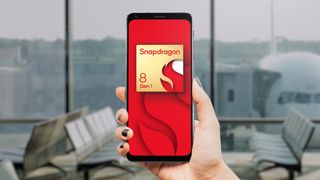The next flagship Qualcomm Snapdragon chip could have a major video upgrade
AV1 for the people

Many of the top-end Android phones of 2022 are going to come running the Qualcomm Snapdragon 8 Gen 1, but we're already hearing rumors of a possible Gen 2 update next year – and improved video codec support could be one of the major upgrades.
As per sources speaking to Protocol, Qualcomm is planning to add support for the open-video AV1 codec in a processor due to be released at the end of this year, which sounds very much like the Snapdragon 8 Gen 2 to us.
You may not have heard much about AV1 up to this point, but it's a way of storing video that offers better compression than current standards – and that of course means it can be delivered over the internet more quickly. It means that the Android devices of 2023 should be able to stream higher resolution videos more quickly.
Maintaining standards
One of AV1's biggest supporters is Google, and the standard is widely used on YouTube. It's also been adopted by Netflix, although for the time being other major streaming platforms – including Disney Plus and HBO Max – haven't made the switch over to AV1.
Google is also pushing the standard for newer Android TV devices, and while it isn't supported by any Chromecast currently on the market, support for AV1 may well appear in the next Chromecast with Google TV that gets unveiled.
From the information obtained by Protocol – including the internal name of the AV1-supporting chip, which is SM8550 – it seems as though we won't be seeing it as a feature in the Snapdragon 8 Gen 1 Plus upgrade expected in the coming months.
Analysis: what AV1 means for you
It can be difficult to get excited about a change in video codec standards, but if you think about how much video we're all streaming over the internet every day, it becomes clear how important a new and improved standard could be.
Get daily insight, inspiration and deals in your inbox
Get the hottest deals available in your inbox plus news, reviews, opinion, analysis and more from the TechRadar team.
In simple terms, AV1 means improved compression and smaller file sizes for videos without any loss of quality. That's going to be a benefit not just for today's streams but for high-resolution 8K streams when they become more commonplace online.
AV1 can be as much as 30% more efficient than the current default standard codec, HEVC (H.265). It has also been designed to be royalty-free, making it cheaper for device manufacturers, video platforms, and (hopefully) end users. The problem is that device makers won't add support for AV1 until a lot of video is served up using it, and video platforms won't invest in the switch until the hardware is there.
The shift should now start moving more rapidly as companies such as Qualcomm get on board – with the Exynos 2100 and Exynos 2200 chips (the latter powers the Galaxy S22 in some regions), Samsung has been supporting AV1 since 2021.

Dave is a freelance tech journalist who has been writing about gadgets, apps and the web for more than two decades. Based out of Stockport, England, on TechRadar you'll find him covering news, features and reviews, particularly for phones, tablets and wearables. Working to ensure our breaking news coverage is the best in the business over weekends, David also has bylines at Gizmodo, T3, PopSci and a few other places besides, as well as being many years editing the likes of PC Explorer and The Hardware Handbook.
